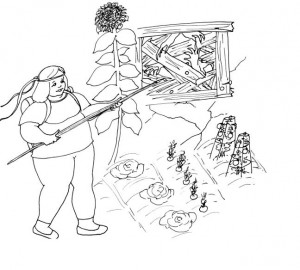About a year ago an acquaintance whispered in my ear that he had a friend I *really* should get to know. I took his suggestion and began to stalk B. Fox. (You can too, on twitter @thebranfox). In her I found a kindred spirit: an artist, a writer, a mother. (A fellow doodler <3). She is currently working on a manga inspired by her daughter and collaborating with a friend to write and illustrate a religious satire. When I discovered she had written and illustrated The Slow-Moving Person’s Guide to the Zombie Apocalypse, I could hardly restrain myself.  I asked her if she wouldn’t mind writing a guest post to fill my slot here (complete some illustrations of slow-movers, doing what they need to do.)
………………………………………………………
 You, the aspiring unpaid writer, illustrator, creative type – I empathize with you. In this modern world we are distracted from our creative work by day jobs, significant others, and late night sprints to the convenience store for milk so little Timmy can eat breakfast tomorrow. We may have dental appointments to get to. We may have to wash our grandmothers. As joyful as grandmother-washing can be, time drains like these are the enemies of productivity.
You, the aspiring unpaid writer, illustrator, creative type – I empathize with you. In this modern world we are distracted from our creative work by day jobs, significant others, and late night sprints to the convenience store for milk so little Timmy can eat breakfast tomorrow. We may have dental appointments to get to. We may have to wash our grandmothers. As joyful as grandmother-washing can be, time drains like these are the enemies of productivity.
Finding time to write or draw when you’re a part-time creative is never as cut and dried as looking at a clock to decide which minute hand configuration you’d like to start on. As I wrote and illustrated The Slow-Moving Person’s Guide to the Zombie Apocalypse, I learned how to fit creative time around my schedule as a home schooling parent, and a freelance writer working for ‘the man.’ Now I offer this semi-preachy advice as a shining beacon of encouragement to you.
Stay Flexible
I’ve seen myriad advice columns for writers that recommend 1. Writing at the same time every day, 2. Writing in the same ‘writing spot.’ (or drawing spot, or yarn-tying spot.) This surely works for people who don’t have to juggle the needs of other people. For those without that luxury, a few adjustments are in order.
Apartment dwellers understand that space can be at a premium. AÂ designated writing desk/corner/room/special chair may not happen when you have to share that space with others. One way I found to keep working on my projects without a dedicated writing space was to carry my work around. I kept drawings for the SMP Guide in a manila folder along with notes I had made, pens, and the extension cord for my laptop, all tucked inside a carrying bag. This enabled me to take my work from room to room based on whatever spot was free from the sounds of battle on the XBox, the chaos of preparing dinner, or if someone actually wanted to sleep on the bed instead of me using it as an office.
A dedicated writing time may not be feasable, either. I worked around this by writing whenever I could. For example, a paragraph while waiting for the pot to boil, or during the last ten minutes of lunch breaks or between school lessons.
This path to writing success is certifiably slow, but eventually – and maybe it is a long eventually – the project gets done. Consider this scripture from the book of St. Pete the Plodding: “Yea verily, though thou worketh slowly, thou wilt taste the fruits of thine labor after an indeterminate length of time.”
 Keep at it
Keep at it
Though I couldn’t write at the same time each day, I found it was important to work on my project daily. This helped me maintain a connection to my work, even if it was in the form of skimming a paragraph and changing a few sentences.
We all have days when life is especially chaotic. It’s okay to not get pages and pages done if you don’t have the energy or time, but it is a good idea to try and get something done, however small, in order to keep your project moving forward. Again, I defer to the wisdom of St. Pete the Plodding: “Keepeth thy work at hand and handle it as thou wouldst thy daily bread, for it needeth daily handling.”
Breaking the project into small, attainable pieces also helped me get the SMP Guide done. I made daily goals to finish one illustration, revise one passage, or write the rough draft of one new page. This kept me from feeling deflated because I had clear markers of progress. This method also kept me from feeling discouraged about my slow progress toward finishing, or from gazing into the massively wide vortex of despair we call ‘the big picture.’
Be good to yourself
Switching from day job mode, make dinner mode, or haggle over the necessity of doing homework mode to creative mode can be a challenge when time is short, and you want to make some kind of progress on your project by the time you nod off where you stand. There are ways to jump the channels, so to speak, and though these might cut into production time, they’re more than worth it. Try one or all of these:
~Meditating for 10-20 minutes
~Take a 5-10 minute power nap
~Spend 20-30 minutes journaling or free drawing
~Go for a quick walk around the neighborhood
~Take a brisk shower
The object of these activities is to make a mental break between the drudgery of everyday chores, and transition into your creative self. The break doesn’t have to be long, only long enough to quiet your mind and signal your muse you’re ready for a visit. Of course, if bathing your grandmother is what relaxes you, by all means use your time with her for you.
Equally as important to preparing yourself is to reward yourself when you complete the task. The rewards do not have to be physical or monetary, but can be thirty minutes of sinfully banal television, a hot bath, or a bicycle ride. Diamonds and submarines are also fantastic rewards if you have the means. Chocolate bars are nice, too. I rewarded myself with a new isotope of Uranium-235 when I finished the first draft of the SMP Guide.
 Slow and steady wins the race
Slow and steady wins the race
Finishing your book at a slow-writing rate may seem daunting, but it is not impossible. If you are a part-time photographer compiling images for an exhibition, or you have to prepare your indigenous noodle art around a full day job schedule, the key is to keep at it. You’ll get there, even if you have to do it really slowly, and kudos to you for even starting. You deserve a pat on the back or a shiny new nugget of Plutonium; whatever makes you feel like the amazing person you are.
07/10/2011 at 3:30 pm Permalink
That’s it in a nutshell. I have two daughters (6 and 10). Most mornings I get up early for a bit of writing, the rest is piece meal. It’s surprising how much progress you can make in 5 and 10 minute bits throughout the day. Sometimes I just leave my laptop plugged in on the kitchen counter, unless it’s in danger from imminent cooking.
07/10/2011 at 7:03 pm Permalink
As someone who keeps falling flat on her face by *trying* to move too fast…. this is VERY applicable. Thank you B. Fox.
(and yes, I often have my laptop propped up on the kitchen counter next to my dinner-time preparations. Watch out for splatters!)
09/10/2011 at 9:42 pm Permalink
Exactly what niltoy.net has been preaching for nearly 6 years! 🙂